About This Journal
Horticultural Science and Technology (abbr. Hortic. Sci. Technol., herein ‘HST’; ISSN, 1226-8763), one of the two official journals of the Korean Society for Horticultural Science (KSHS), was launched in 1998 to provide scientific and professional publication on technology and sciences of horticultural area. As an international journal, HST is published in English and Korean, bimonthly on the last day of even number months, and indexed in ‘SCIE’, ‘SCOPUS’ and ‘CABI’. The HST is devoted for the publication of technical and academic papers and review articles on such arears as cultivation physiology, protected horticulture, postharvest technology, genetics and breeding, tissue culture and biotechnology, and other related to vegetables, fruit, ornamental, and herbal plants.



-
Research Article

- A Pruning Criterion for Dormant ‘Niitaka’ Pear Trees that Uses a Decision Tree Model Based on the Basal Diameter of Bearing Branches
- Ju Eun Kim, So-Yeon Park, Ung Yang, Seung Gon Wi, Min Soo Kim, Sun Woo Chung, Sang-Hyun Lee
- Criteria for the selective pruning of pear trees are required at this time as the number of experienced pruning workers continues to …
- Criteria for the selective pruning of pear trees are required at this time as the number of experienced pruning workers continues to decline. The present study aimed to analyze the occurrence of water sprouts and fruit yields according to bearing branch basal diameters and establish pruning criteria for pear trees. During a three-year dormancy period, the lengths and diameters of water sprouts and bearing branches on ‘Niitaka’ pear trees were measured, and the data were analyzed with Python and R. Bearing branch thickness and sprouting vigor increased with age. Fruit yield initially increased with the bearing branch basal diameter and remained constant thereafter. A correlation analysis of water sprout occurrences and variations in the bearing branch basal diameters identified the explanatory variables used to build a decision tree and establish pruning criteria. A feature importance analysis revealed that the bearing branch basal diameter had the greatest impact on the output of the decision tree. The latter recommended pruning when the bearing branch central and basal diameters exceeded 26.2 mm and 42.3 mm, respectively. We believe that the results of the present study provide guidelines for improving pruning accuracy and efficiency through model-based decision-making. - COLLAPSE
-
Research Article

- Growth and Quality of Leafy Sweet Potatoes Grown Hydroponically under Different EC Conditions in a Plant Factory
- Dong Hyun Han, Yurina Kwack
- Leafy sweet potato [Ipomoea batatas (L.) Lam] is developed primarily for its leaves rather than its roots, which are rich in …
- Leafy sweet potato [Ipomoea batatas (L.) Lam] is developed primarily for its leaves rather than its roots, which are rich in secondary metabolites such as lutein. As limited studies have explored the production of leafy sweet potato in a plant factory with artificial lighting (PFAL), this study aimed to investigate the growth and quality responses of leafy sweet potato to different electrical conductivity (EC) levels in the nutrient solution and to determine the optimal EC for hydroponic cultivation in a PFAL. Two cultivars, ‘Tongchaeru’ and ‘Suioh’, developed for leaf consumption in Korea and Japan, respectively, were used. Controlled environmental conditions were used, specifically an air temperature of 25/22°C, relative humidity of 65 ± 5%, light intensity of 250 µmol∙m-2∙s-1, and a photoperiod pf 16 h in a plant factory that used white LEDs. Nutrient solutions with four different EC levels (1.0, 2.0, 3.0, and 4.0 dS·m-1) were supplied to leafy sweet potatoes. At 35 days after transplanting tissue-cultured seedlings, the EC 2.0 dS·m-1 treatment resulted in the highest overall growth in both cultivars. The anthocyanin content in ‘Tongchaeru’ was highest at EC 1.0 dS·m-1, followed by EC 4.0 dS·m-1, while in ‘Suioh’, it was highest at EC 4.0 dS·m-1. The lutein content showed a substantial increase at EC 4.0 dS·m-1 in both cultivars. Intumescence symptoms were observed under all EC treatments and in both cultivars, with greater severity in ‘Suioh’. In leaves exhibiting intumescence, stomatal conductance and the anthocyanin content were lower than in normal leaves, whereas the lutein content increased under high EC conditions. These results suggest that an EC of 2.0 dS·m-1 is optimal for biomass production, while EC 4.0 dS·m-1 is favorable for the accumulation of functional compounds. Further studies are needed to optimize hydroponic strategies for simultaneously enhancing the yield and phytochemical accumulation. This study provides a foundational basis for developing production systems for leafy sweet potato in PFALs. - COLLAPSE
-
Research Article
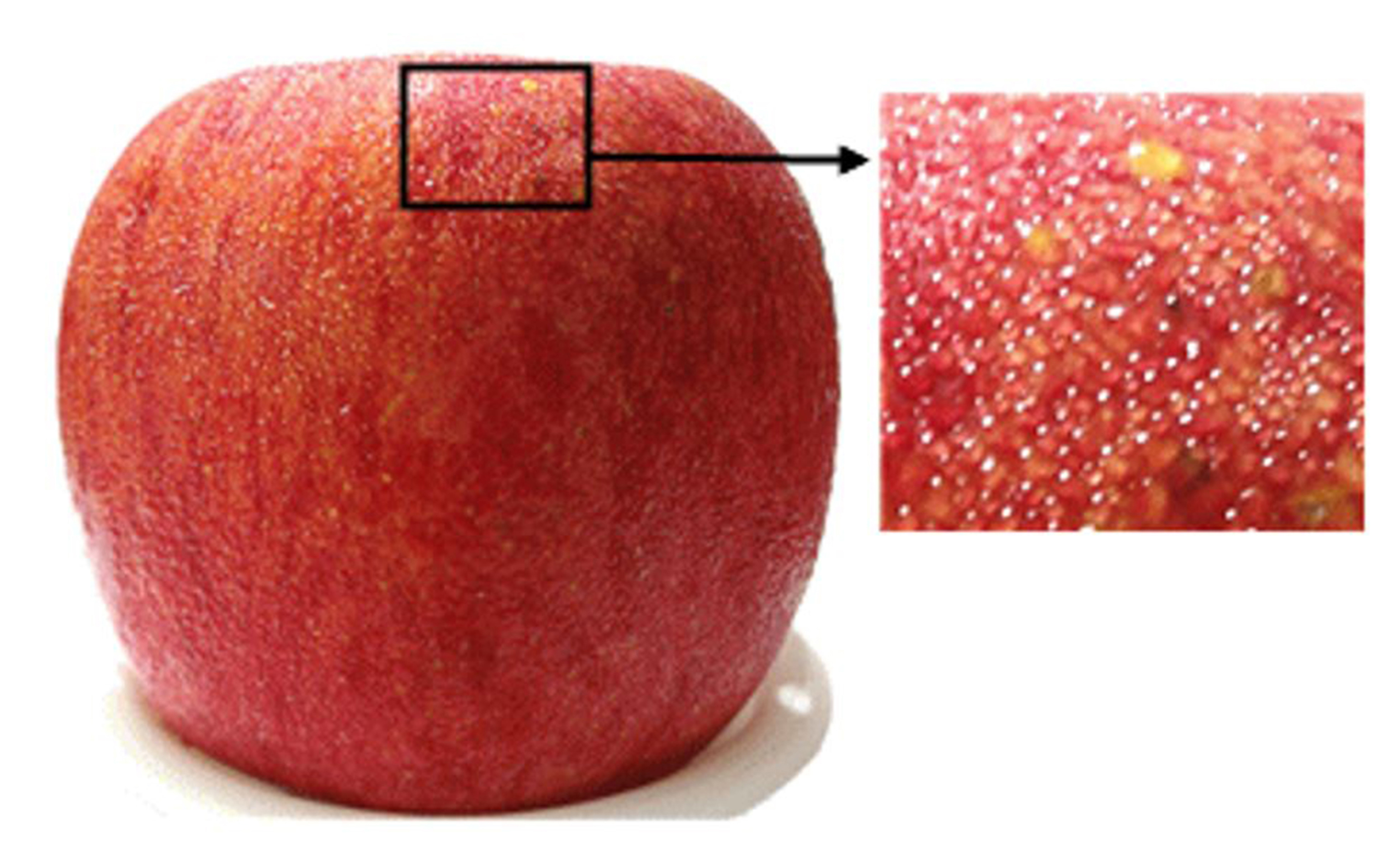
- Prediction and Validation of Water Condensation on Cold-stored Apples under Various Hygrothermal Conditions in a Packinghouse
- Youn-Moon Park, Jong Kee Kim, Heui Taek Lim, Mi Hyang Park, Eun Hwa Lim, Cheon-Soon Jeong
- Fruit condensation after cold storage diminishes operational efficiency and increases the risk of microbial contamination during packinghouse and distribution operations. Water condensation …
- Fruit condensation after cold storage diminishes operational efficiency and increases the risk of microbial contamination during packinghouse and distribution operations. Water condensation on cold-stored apples was predicted using psychrometric methods and validated through laboratory investigations to offer effective fruit temperature control guidelines. A survey conducted in 2023 at eight agricultural product processing centers (APCs) revealed that the storage temperatures and relative humidity (RH) levels for apples ranged from 0.0 to 1.0°C and exceeded 85%, respectively. Packinghouses were managed under ambient conditions or air-conditioned environments, targeting atmospheres of 20°C with 60% RH. A theoretical estimation of the vapor pressure deficit (VPD) between the fruit and packinghouse environments indicated that raising the fruit temperature to prevent water condensation could be realized at temperatures ranging from 0.5°C to 17°C, depending on the atmospheric conditions. The fruit temperature for vapor pressure equilibrium (VPE) was 12.5°C under the targeted environmental condition of 20°C with 60% RH. Six treatments, combining the fruit temperatures with atmospheric simulations inside a packinghouse, were applied as a validation experiment. The simulated atmospheric temperature and humidity conditions were 10°C and 20°C with 50% RH and 80% RH, respectively, for 0°C fruit temperature, and 20°C with 60% RH and 80% RH at 12°C. The laboratory experiment demonstrated that water condensation varied among the treatments, consistent with the theoretical VPD estimations. A significant regression model was developed between the VPD and the amount of condensation on the apples. The results of this study suggest the feasibility of psychrometrics for detailed and effective temperature management strategies for cold-stored apples during packinghouse operations. - COLLAPSE
-
Research Article
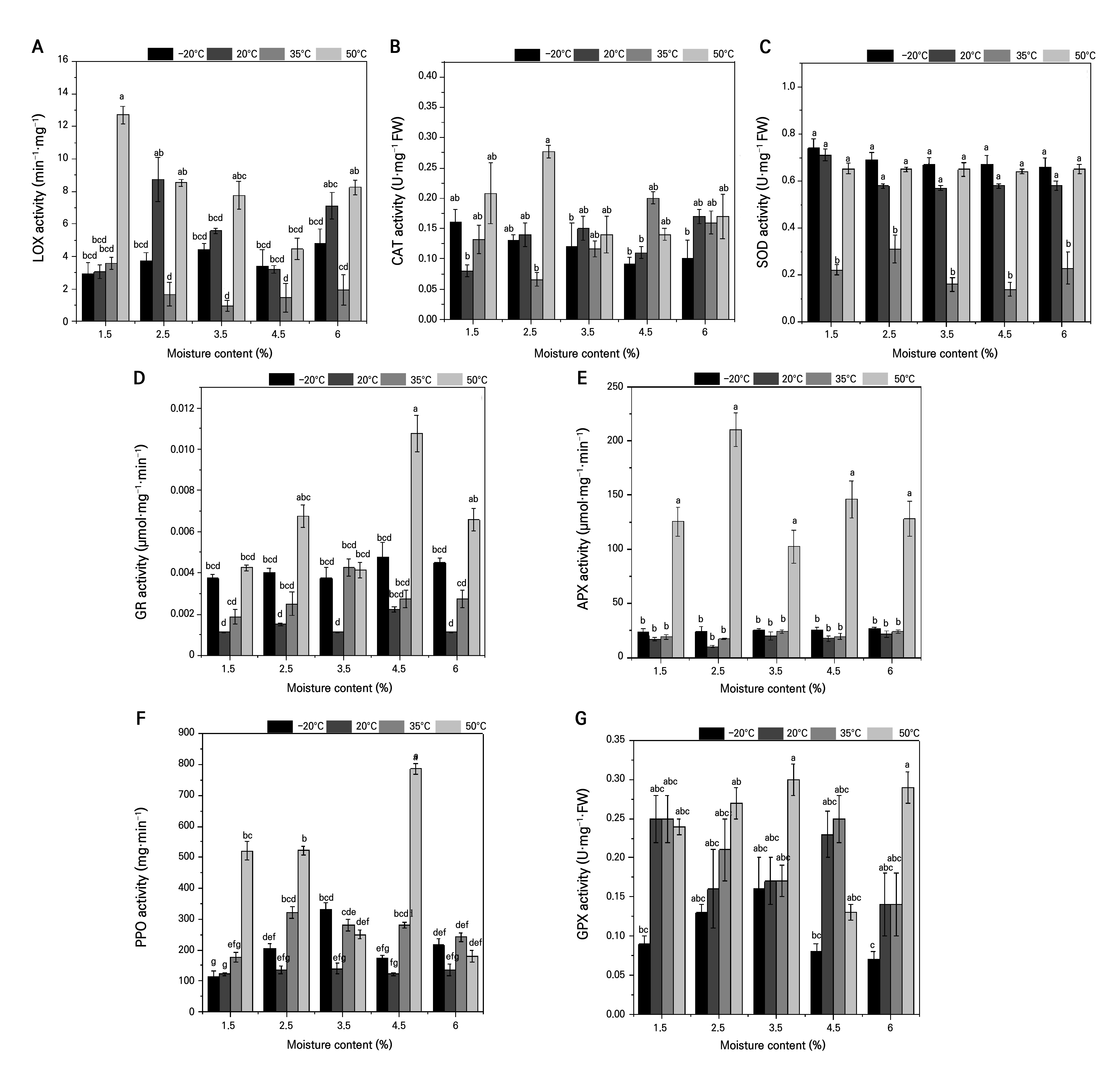
- Physiological and Biochemical Responses of Allium mongolicum Regel Seeds to Drying Treatments at Various Temperatures
- Zhenyu Cao, Pengchao Wei, Fenglan Zhang, Xiaoyan Zhang, Zhongren Yang
- This study investigated the mechanism and feasibility of drying Allium mongolicum Regel seeds to different moisture content (MC) levels for storage. The …
- This study investigated the mechanism and feasibility of drying Allium mongolicum Regel seeds to different moisture content (MC) levels for storage. The seeds were dehydrated to five MC levels ranging from 1.5% to 6.0% and stored at −20, 20, 35, and 50°C for up to 420 days. Seed vigor and various physiological and biochemical indicators were subsequently evaluated. Both germination and vigor were significantly influenced by the storage temperature and MC. Seeds dried to a moderate MC level (4.5–6.0%) and stored at 20–35°C showed higher germination percentages compared to non-dehydrated or over-dehydrated seeds. Moreover, extreme storage temperatures (−20°C or 50°C) suppressed germination vigor and antioxidant enzyme activity while increasing the accumulation of harmful metabolites, thereby accelerating seed deterioration. Germination percentage was positively correlated with soluble protein and proline contents, as well as polyphenol oxidase (PPO) and catalase (CAT) activities; it was negatively correlated with glutathione peroxidase (GPX) activity, the malondialdehyde (MDA) content, and the superoxide anion (O2‒) production rate. These correlations were especially evident in seeds with 4.5–6.0% MC. Therefore, drying seeds to 4.5–6.0% MC and storing them at 20–35°C for 180–360 days is recommended for the optimal preservation of A. mongolicum germplasm resources. - COLLAPSE
-
Research Article

- Graphical Tracking and Quantitative Grading for Quality Assurance of Grafted Tomato Seedlings
- Solly Kang, Yu Kyeong Shin, Young Eun Jeon, Hyejin Lee, Jun Gu Lee
- In this study, we aimed to establish quantitative growth standards and quality assessment methods for grafted tomato (Solanum lycopersicum L.) seedlings …
- In this study, we aimed to establish quantitative growth standards and quality assessment methods for grafted tomato (Solanum lycopersicum L.) seedlings through a comprehensive analysis of developmental patterns across five production cycles. The growth parameters of scion, rootstock, and grafted seedlings were monitored from cotyledon emergence through the shipping stage over 49 d in both spring and autumn seasons. The results revealed that spring production achieved superior growth, with shipping-stage seedlings reaching 18.43 ± 0.34 cm in height, 181.05 ± 6.34 cm2 in leaf area, and 10.261 ± 0.432 g in fresh weight compared with the corresponding autumn values of 16.85 ± 0.40 cm, 160.03 ± 4.58 cm2, and 8.362 ± 0.214 g. Rootstock consistently outperformed scion genotypes during early development, with 25% greater leaf area and 30% higher biomass at the pre-grafting stage. Following successful graft union, exponential growth acceleration occurred between 35 and 49 d after sowing, with the leaf area increasing 3.6-fold and fresh weight increasing 3.5-fold. A novel graphical tracking system was developed to visualize temporal growth patterns across seven key parameters, establishing standard ranges based on mean values ±1 standard deviation (SD). A five-point quality grading system was introduced, assigning scores based on deviation from mean values, with measurements within ±0.5 SD receiving the highest score. This integrated approach provides objective benchmarks for commercial nursery operations, enabling standardized quality assessment and timely environmental adjustments throughout the tomato production cycle. The established standards represent critical tools for optimizing the production of grafted tomato transplants and ensuring consistent seedling quality across different growth conditions. - COLLAPSE
-
Research Article
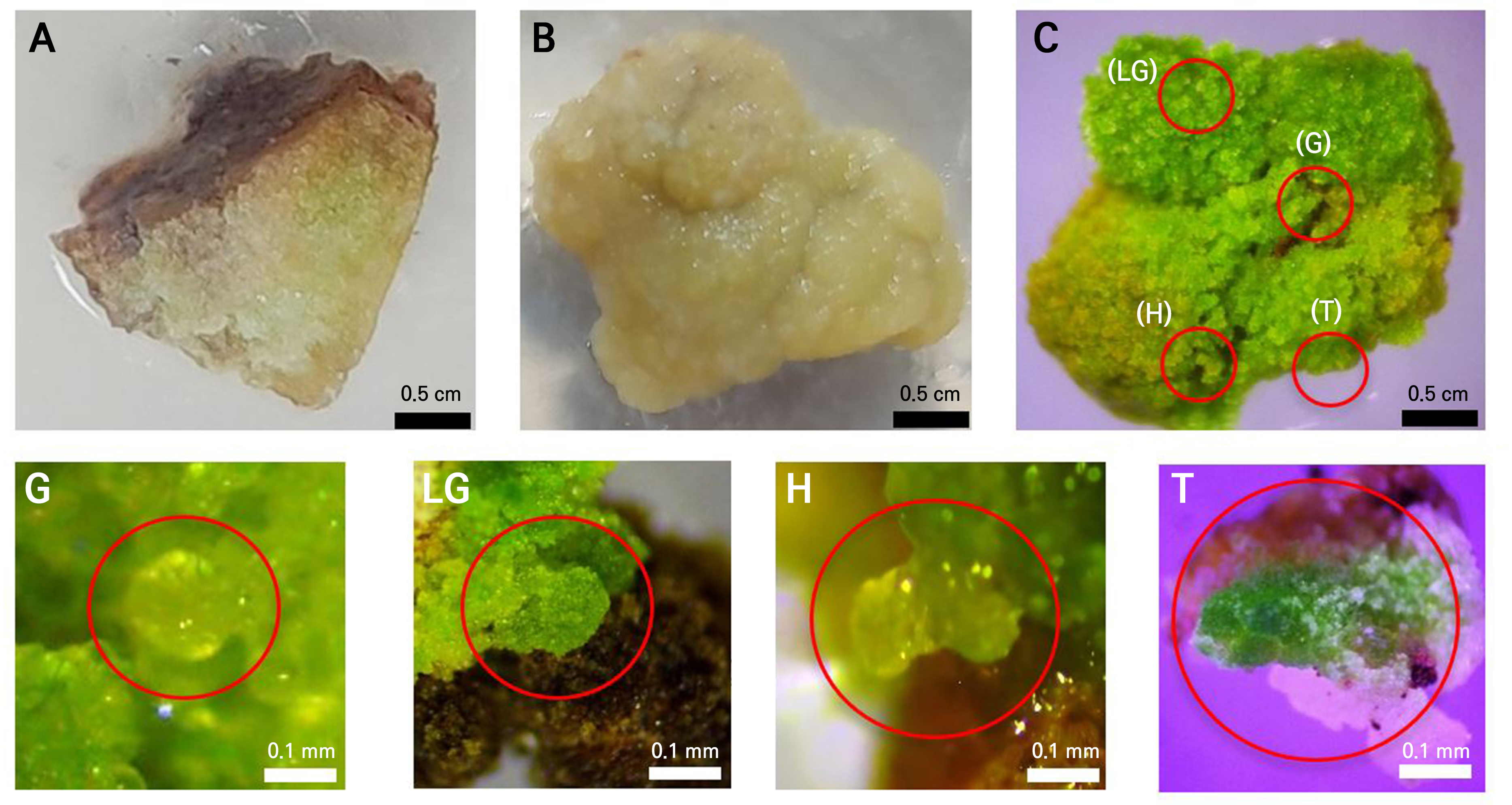
- Encapsulation of Jamblang (Syzygium cumini) Somatic Embryos with Variations in the Alginate Concentration, Temperature, and Storage Duration
- Exsyupransia Mursyanti, Clara Skivo Ganita Anjani, Gregorius Pramudito Rahmadi, Nelsiani To’bungan, Patricius Kianto Atmodjo, Paulus Wisnu Anggoro
- Jamblang (Syzygium cumini) is a widely known medicinal plant that can be used to treat various diseases. Seeds of the …
- Jamblang (Syzygium cumini) is a widely known medicinal plant that can be used to treat various diseases. Seeds of the plant are recalcitrant, as evidenced by their high moisture content with a low storage capacity, which reduces their viability. Therefore, this study aims to determine the best hormone combination to induce an embryogenic callus of S. cumini leaves. A total of six hormone combinations were tested at this stage. The study was also carried out to determine the best alginate concentration, the optimum temperature, and the proper storage duration for S. cumini somatic synthetic embryo encapsulation. The parameters observed were the morphology and characteristics of the S. cumini somatic embryo as well as the quality of seeds with the best physical properties and regeneration ability. Alginate concentrations of 2%, 3%, and 4% were tested as parameters for the physical properties, while the regeneration ability was evaluated using the same alginate concentrations with storage durations of 15, 30, and 45 days at temperatures of 15°C and 25°C. The optimal induction of the embryogenic callus was achieved with 2 mg L-1 2,4-D in the absence of BAP, producing a callus with an intermediate texture and yellow-green coloration. The histology of the embryogenic callus cells showed a large nucleus, a round shape, a small size, a thick cell wall, and dense cytoplasm. An alginate concentration of 3% and a storage time of 30 days at 15°C and 25°C produced S. cumini somatic synthetic embryo seeds with the best physical properties and regeneration ability. Optimization of the regeneration medium and the induction of embryos at the green cotyledonary stage are essential for successful somatic embryo encapsulation and subsequent shoot development. - COLLAPSE
-
Research Article

- Comparative Analysis of the Environmental, Sap Flow, and Growth Characteristics of Paprika in Positive-Pressure and Non-Pressurized Semi-Closed Greenhouses
- Yoon Go, Se Hun Ju, Eun Ji Kim, Young Je Kim, Yong Hwan Jeon, Haeyoung Na
- This study compared the internal environment, growth characteristics, and sap flow of paprika (Capsicum annuum L.) grown in a positive-pressure semi-closed …
- This study compared the internal environment, growth characteristics, and sap flow of paprika (Capsicum annuum L.) grown in a positive-pressure semi-closed greenhouse (PP-SCG) and a non-pressurized semi-closed greenhouse (NP-SCG) to analyze differences in growth and productivity according to the greenhouse structure. Data collected from two greenhouses in Gangjin-gun, Jeollanam-do, between August 1 and September 4, 2024, showed that the PP-SCG maintained a narrower diurnal temperature range and a more stable average temperature than the NP-SCG. While the relative humidity in the NP-SCG exceeded 80% throughout the study period, the PP-SCG recorded many days a relative humidity rate below this threshold. Sap flow was consistently higher in the PP-SCG, correlating with superior growth and yield outcomes. A multiple linear regression analysis revealed that in both greenhouses, a 1°C increase in the internal temperature increased the sap flow by 0.043 mm·s-1, whereas a 1% increase in RH reduced the sap flow by 0.039 mm·s-1 in the PP-SCG and by 0.018 mm·s-1 in the NP-SCG. These findings suggest that sap flow is a reliable real-time indicator of crop physiological responses, extending beyond its traditional role as a measure of water movement. NP-SCG control systems primarily focus on external factors such as light, temperature, and humidity. Integrating sap flow sensors to monitor internal water transport and physiological activity could enable more precise crop diagnostics and rapid environmental adjustments. Such an integrated control strategy is expected to enhance smart-farm management systems by enabling decisions based on actual crop responses rather than solely on external conditions. - COLLAPSE
-
Research Article
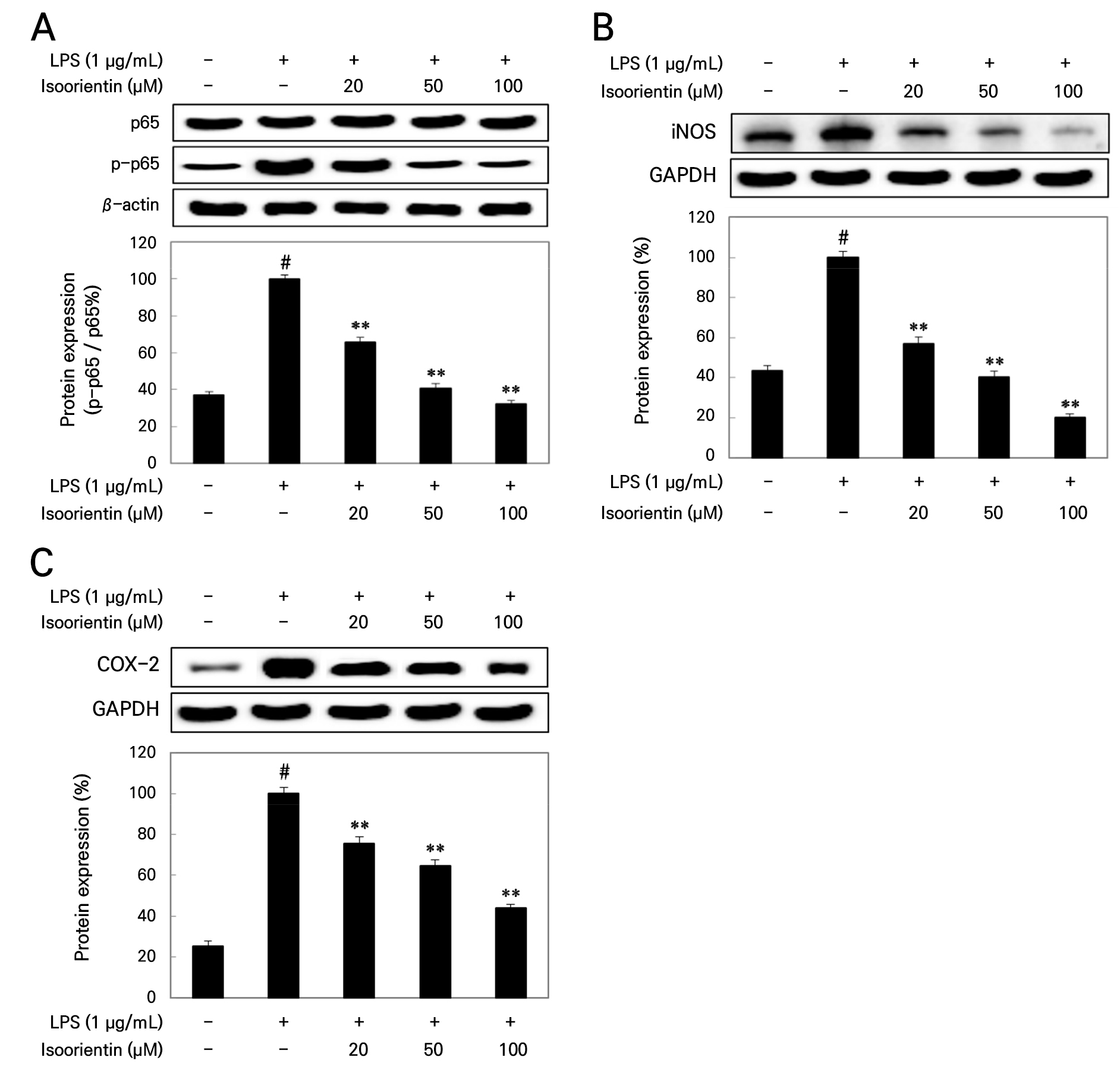
-
Inhibition of p-65, COX-2, iNOS and Cytokine Inflammation Signaling Pathway by Purified isoorientin from Oplismenus undulatifolius on Pro-inflammatory Responses
주름조개풀(Oplismenus undulatifolius)에서 분리된 Isoorientin이 Inflammation Signaling Pathway에서 p-65, COX-2, iNOS 및 염증성 Cytokine의 억제에 미치는 영향
-
Eun-Ho Lee, Chae-Won Han, Dong-Hee Kim, Byung-Oh Kim, In-Kyu Kang, Young-Je Cho
이은호, 한채원, 김동희, 김병오, 강인규, 조영제
- Isoorientin is a component ofbeen in medicinal plants. In this research, isoorientin was purified from Oplismenus undulatifolius and its ability to inhibit …
야생초인 주름조개풀에 존재하는 isoorientin이 가지는 항염증 효과와 작용 mechanism에 대한 물질 본연의 연구가 부족하여 isoorientin이 염증반응에 관여하는 기전을 밝히고자 시도하였다. Isoorientin의 세포 …
- Isoorientin is a component ofbeen in medicinal plants. In this research, isoorientin was purified from Oplismenus undulatifolius and its ability to inhibit inflammation was investigated. Cell toxicity was not expressed at concentrations below 100 μg/ mL of isoorientin. iNOS-derived NO and COX-2-derived PTGES2 m-RNA expression inhibition activities by the extracts which were found to be determined by the isoorientin concentration. Also, the cytokine and chemokine inhibitory activities of TNF-α, IL-6, IL-1β and MCP-1 via a pre-inflammatory mechanism were decreased upon an addition of isoorientin. The results here show that isoorientin decreases inflammatory reactions in Raw 264.7 cells with LPS via the regulation of iNOS, COX-2, NO, PTGES2, and cytokines and chemokines, demonstrating that isoorientin from Oplismenus undulatifolius is an excellent functional resource with strong anti-inflammatory activity.
- COLLAPSE
야생초인 주름조개풀에 존재하는 isoorientin이 가지는 항염증 효과와 작용 mechanism에 대한 물질 본연의 연구가 부족하여 isoorientin이 염증반응에 관여하는 기전을 밝히고자 시도하였다. Isoorientin의 세포 독성을 측정한 결과, 100µg/mL 농도까지 독성이 없는 것으로 관찰되어 처리 농도 구간을 20–100µg/mL로 선정하였다. LPS로 자극한 Raw 264.7 cell에서 p65, iNOS, COX-2와 같은 염증매개체와 염증성 cytokine 및 chemokine의 발현은 isoorientin에 의하여 농도 의존적으로 억제되는 것을 확인하였다. 따라서 isoorientin에 의한 염증 억제효과는 p65, iNOS와 COX-2 등의 발현을 억제함으로써 염증반응에 관련된 물질인 NO, PTGES2, NF-α, IL-6, IL-1β 및 MCP-1 등의 생성을 억제하는 기작을 나타내는 것으로 확인되었다. 그러므로 주름조개풀에 존재하는 isoorientin은 염증성 질환에서 다양한 염증성 물질의 과발현에 의해 유도되는 염증성 질병의 치료제로 활용할 수 있는 기능성소재로 사용될 수 있을 것으로 판단되며, 주름조개풀의 약리성 기능성 소재로 활용하기 위한 유용한 자료로 활용할 수 있을 것이다.
-
Inhibition of p-65, COX-2, iNOS and Cytokine Inflammation Signaling Pathway by Purified isoorientin from Oplismenus undulatifolius on Pro-inflammatory Responses
-
Research Article

-
Comparative Genomic and Expression Analysis of MADS-box Gene family in Apple and Pear under Cold Stress
사과 및 배 MADS-box 유전자의 비교 유전체 분석 및 저온 스트레스 반응 특성 규명
-
Jun Seo Gi, Jun Hyeok Kim, Hye Jeong Cho, Tae Yeong Lim, Seungill Kim
길준서, 김준혁, 조혜정, 임태영, 김승일
- MADS-box genes encode transcription factors critical for plant development, flowering, and stress responses. We re-annotated MADS-box genes in apple (Malus domestica …
MADS-box 유전자는 식물 발달, 개화 및 스트레스 반응에 필수적인 전사인자를 암호화한다. 본 연구는 경제적으로 중요한 두 장미과 종인 사과(Malus domestica)와 …
- MADS-box genes encode transcription factors critical for plant development, flowering, and stress responses. We re-annotated MADS-box genes in apple (Malus domestica) and pear (Pyrus pyrifolia), two economically significant Rosaceae species, revealing 113 previously unannotated genes. Comparative genomic analyses with Arabidopsis and other species highlighted evolutionary divergence, with domain and motif analyses demonstrating stronger conservation in MIKC-type genes compared to the M type. Phylogenetic reconstruction traced lineage-specific expansions, while a CAFE analysis identified SOC1 as the most rapidly expanding subfamily in Pyrus pyrifolia, likely driven by whole-genome duplication events—a pattern consistent with recent synteny network studies in Rosaceae. Under cold stress, expression profiling in Pyrus pyrifolia revealed a significant downregulation of SOC1, suggesting its role in temperature-sensitive signaling pathways. A co-expression network analysis further implicated PPYR_MADS_102 and PPYR_MADS_56 as key candidates for cold resistance, potentially regulating dormancy or stress-responsive pathways. Our study provides a refined genomic resource for Rosaceae, elucidates the evolutionary dynamics of MADS-box subfamilies, and identifies functional targets for improving cold tolerance in horticultural species.
- COLLAPSE
MADS-box 유전자는 식물 발달, 개화 및 스트레스 반응에 필수적인 전사인자를 암호화한다. 본 연구는 경제적으로 중요한 두 장미과 종인 사과(Malus domestica)와 배(Pyrus pyrifolia)에서 MADS-box 유전자를 재동정하였으며, TGFam-Finder를 사용하여 이전에 동정되지 않았던 113개의 유전자를 발견했다. 애기장대(Arabidopsis) 및 다른 종들과의 비교 유전체 분석은 MADS-box 유전자의 진화적 분화를 보여주었으며, 도메인 및 모티프 분석 결과 M-type에 비해 MIKC-type 유전자에서 더 강한 보존성이 나타났다. 계통수 분석은 계통 특이적 확장을 추적하였고, CAFE 분석 결과 Pyrus pyrifolia에서 SOC1이 가장 빠르게 확장하는 subfamily임을 확인했다. 이는 전체 유전체 중복 사건에 의해 유도된 것으로 보이며, 장미과(Rosaceae)의 최근 유전자 배열 유사성(synteny) 네트워크 연구와 일치하는 패턴이다. 저온 스트레스 하에서 배(Pyrus pyrifolia)의 발현 프로파일 분석 결과, SOC1의 유의미한 발현 감소가 나타났으며, 이는 온도 감응성 신호 전달 경로에서 SOC1의 역할을 시사한다. 공동 발현 네트워크 분석은 PPYR_MADS_102와 PPYR_MADS_56이 저온 저항성의 주요 후보 유전자이며, 휴면 또는 스트레스 반응 경로를 조절할 가능성이 있음을 추가적으로 시사한다. 본 연구는 장미과 식물에 대한 정제된 유전체 자원을 제공하고, MADS-box subfamily의 진화적 동력을 밝히며, 원예 작물의 저온 내성을 개선하기 위한 기능적 표적 유전자를 제시한다.
-
Comparative Genomic and Expression Analysis of MADS-box Gene family in Apple and Pear under Cold Stress
-
Research Article

-
Daily Transpiration Change Estimations using the Leaf Temperature according to Paprika Growth in a Venlo-type Greenhouse
벤로형 온실에서 파프리카의 생육에 따른 엽온을 이용한 일증산량 변화 추정
-
Seung Mi Woo, Dong Hee Noh, Sung Woo Byun, Ho Cheol Kim
우승미, 노동희, 변성우, 김호철
- This study was conducted to estimate transpiration rate changes using the leaf temperature as monitored throughout the full cultivation cycle in a …
본 연구는 실제 파프리카(Capsicum annuum L.) 재배되고 있는 벤로형 온실 내에서 전주기 동안 모니터링한 엽온을 이용하여 증산량 변화를 추정하기 위해 수행되었다. …
- This study was conducted to estimate transpiration rate changes using the leaf temperature as monitored throughout the full cultivation cycle in a Venlo-type greenhouse where paprika (Capsicum annuum L.) was actually being grown. All data were collected from November of 2022 to June of 2023 after the paprika was planted in August of 2022. During the experimental period, the average daytime temperature inside the greenhouse ranged from 19.4°C to 24.5°C, with the highest values observed in August and September of 2022 and June of 2023, when external solar radiation increased. The average daytime leaf temperature showed a similar trend. An exponential regression analysis was conducted to determine the relationship between the leaf temperature and the transpiration rate, with measurements taken weekly during the experimental period. The R2 value was 0.7700 (p < 0.01), indicating a significant correlation. To estimate the transpiration rate when applying diurnal variations, the third-degree polynomial was derived using relative diurnal transpiration values. The daily transpiration rate (mol·m-2·day-1, TR1) was calculated using the regression equation for transpiration based on the leaf temperature, which was monitored every two minutes. The average TR1 was 36.38 ± 32.87 mol·m-2·day-1, with a minimum of 1.98 mol·m-2·day-1 and a maximum of 249.76 mol·m-2·day-1. When applying the diurnal variation regression equation (TR2), the average value was 15.95 ± 14.60 mol·m-2·day-1 lower than TR1. The daily transpiration per plant (mol·m-2· day-1, TR3) was calculated by applying a regression model of the leaf area change to the TR2 value per unit area (1 m2). According to this method, the average daily transpiration per plant was 26.04 ± 23.98 mol·plant-1·day-1, with a minimum of 1.55 mol·plant-1·day-1 and a maximum of 145.99 mol·plant-1·day-1, showing a large difference between the minimum and maximum values. By multiplying the TR3 value by the weight of 1 mole of pure water (H2O), which is 18 g, the daily transpired water per plant (g·plant-1·day-1, TR4) could be calculated. The average amount of transpired water was 468.70 ± 431.58 g·plant-1·day-1, with a minimum of 27.93 g·plant-1·day-1 and a maximum of 2,627.94 g·plant-1·day-1. When comparing the cumulative increase rates between the estimated transpiration including the calculated transpiration and the moisture content of harvested fruits and the actual crop water uptake data from the farm, the values were 508.55 and 471.31 g·plant-1·day-1, respectively, showing a difference of 37.24 g·plant-1·day-1. This difference is believed to be influenced by crop cultivation management, farm data, and the accuracy of each regression model used.
- COLLAPSE
본 연구는 실제 파프리카(Capsicum annuum L.) 재배되고 있는 벤로형 온실 내에서 전주기 동안 모니터링한 엽온을 이용하여 증산량 변화를 추정하기 위해 수행되었다. 모든 데이터는 2022년 8월에 정식된 후 2022년 11월부터 2023년 6월까지 조사되었다. 실험 기간 동안 온실 내부의 주간평균기온은 19.4–24.5°C였으나 외부 광량이 증가하는 2022년 8, 9월과 2023년 6월에 가장 높았으며, 주간평균엽온 또한 비슷한 경향이었다. 실험 기간 동안 일주일 간격으로 측정한 모든 잎의 엽온과 증산속도 간 관계를 알아보기 위해 지수함수로 회귀분석을 도출한 결과, R2값이 0.7700(p < 0.01)로 유의하게 나타났다. 증산량 추정에 일중 변화를 적용시키기 위해 일중 증산량의 상대값을 활용하여 3차 다항식을 도출하였다. 엽온에 따른 증산량 회귀식에 2분 마다 모니터링된 엽온을 이용하여 일증산량(mol·m-2·day-1, TR1)을 계산하였다. TR1은 평균 36.38 ± 32.87mol·m-2·day-1였다. 그리고 최소 1.98mol·m-2·day-1였고, 최대 249.76mol·m-2·day-1였다. 일중 변화 회귀식을 적용(TR2)하였을 시 적용하지 않은 TR1보다 평균 15.95 ± 14.60mol·m-2·day-1이 낮아졌다. TR2의 단위면적(1m2) 당 계산된 값에 엽면적의 변화 회귀모형을 적용시켜 식물체 당 일증산량(mol·m-2·day-1, TR3)을 계산하였다. 식물체 당 일증산량의 평균 26.04 ± 23.98mol·plant-1·day-1였다. 그리고 최소 1.55mol·plant-1·day-1였고 최대 145.99mol·plant-1·day-1 수준으로 최소값과 최대값의 차이가 매우 컸다. TR3 값에 순수한 물(H2O) 1mole 무게인 18g을 곱하여 일중 식물체 당 증산된 물의 무게(g·plant-1·day-1)로 나타내었다(TR4). 증산된 물의 무게는 평균 468.70 ± 431.58g·plant-1·day-1이었고, 최소 27.93g·plant-1·day-1, 최대 2,627.94g·plant-1·day-1수준을 나타내었다. 농가의 작물 흡수량 데이터와 계산한 증산량 + 수확 과실 수분량을 포함한 추정 증산량을 누적하여 증가속도를 비교한 결과, 각각 508.55, 471.31g·plant-1·day-1로 37.24g·plant-1·day-1차이가 발생했다. 이러한 차이는 작물 재배 관리, 농가 데이터 및 사용된 각 회귀모형의 정확도에 따른 영향이 있을 것으로 판단된다.
-
Daily Transpiration Change Estimations using the Leaf Temperature according to Paprika Growth in a Venlo-type Greenhouse


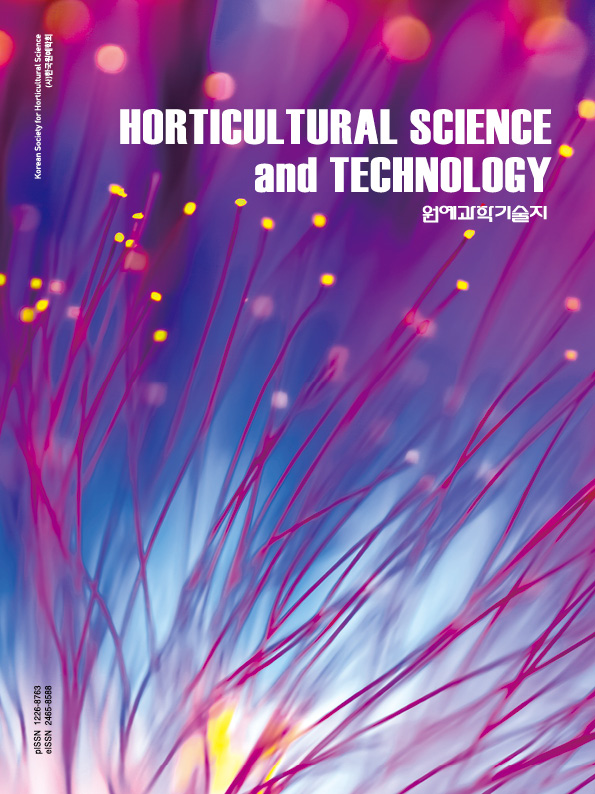 Horticultural Science and Technology
Horticultural Science and Technology








